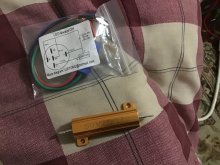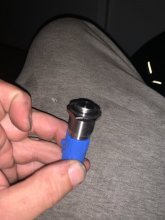See, that sounds to me like you are definitely giving it too much current. It it powers up enough that it does a low voltage disconnect, that is too much. You are only trying to charge up the capacitor(s) on the front-end, and that shouldn't take much current. So, I think a larger resistor would be better.
Several things:
1) The normal procedure is to charge when the inverter is turned off. However, since humans are involved, it is advisable to design for mistakes. Consequently, this discussion is around what happens on pilot error, not in the normal sequence.
2) If the inverter is left on and the voltage is not enough to turn on the logic of the inverter, the capacitors are not getting charged very much either. Note: The resistance would have to be very high for the voltage to never get to the inverter turn on level.
3) The worst scenario would be that the voltage gets high enough to turn on the inverter logic and the drain from the inverter logic is enough to reduce the voltage and turn off the logic....and it sits there and oscillates between on and off. This almost-but-not-quite-on oscillation is not a state you want *any* electronics in. Furthermore, there may be no outward appearance that this is happening.
4) There may be a current value through the resistor where the turned on inverter is draining just enough current that an equilibrium is found that does not have any on-off oscillation and does not turn on..... but I do not know how to find that magic point and the voltage is going to be low enough that the capacitors are not very well charged.
I would rather have it power up and go into the low voltage disconnect state than to let it oscillate. At least then it is in a state the inverter was designed to handle. I am not saying anyone else is wrong.... just giving my perspective on things. The great thing about this forum is that we get to hear everyone's point of view and then pick what works for ourselves....
Note: I use the multi-position battery select switch as shown in link in my previous post. This setup ensures the pre-charge is engaged before the full on position is reached. With the low value resistor, even if the user rushes through the 'charge' position on the switch, the capacitors will be mostly charged. (This is why I prefer it over the push-button solution where the user could forget to push the button or waits too long between pushing the button and flipping the switch.)
 EDIT: Updated the image to add different values for R1. The resistor values are not critical,
EDIT: Updated the image to add different values for R1. The resistor values are not critical,
Switch Position "Off" - "All Off"
Switch Position "1" - Pre-charge
Switch Position "ALL" - Full on
Switch Position "2" - Full on
Since the Perko switch does not allow going from off directly to 'All' or '2', there is no way to go to 'On' without going through Pre-charge.
My only complaint with this design is that the perko switch is rather bulky/big.








